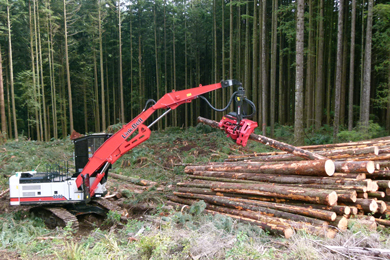While BC forestry companies face a long-term decline in the annual allowable cut in the Interior, thanks to the mountain pine beetle infestation, BC companies on the coast have been exporting raw logs, mostly to China, in record volumes in recent years.
According to a recent Canadian Centre for Policy Alternatives (CCPA) report, one in three trees cut on the BC coast was exported in 2016 – 6.6 million cubic metres – which is slightly short of the 6.9-million-cubic-metre record in 2013. Log exports between 2013 and 2016 generated $3 billion.
So, should the BC government ban or severely restrict raw log exports?
While log exports are not new, their volume and value have increased in recent years, thanks to demand from China, and raw log exports now promise to become an election issue.
The CCPA is recommending a ban on log exports from old-growth forests and higher export taxes on second-growth log exports.
If the NDP has a firm election plank position on the issue, party leader John Horgan won’t say what it is.
“We’re not going to lay it all out at this moment,” he told Business in Vancouver.
Green Party Leader Andrew Weaver said he doesn’t support a ban on log exports. He would rather see incentives given to the pulp and paper industry, which could use some of the low-value logs currently being exported
Much of the timber that is exported in raw log form is hemlock, which is a lower- value wood.
“I don’t think banning is the way to go,” Weaver said. “But differential taxes between logs that export, versus logs that stay, is one way. Appurtenances is another way.”
Under appurtenance rules, which the Liberal government scrapped, trees cut in a given region had to be used in that region to feed local mills
Under appurtenance rules, which the Liberal government scrapped, trees cut in a given region had to be used in that region to feed local mills.
Once those rules were scrapped, logs could be sold to anyone anywhere. Buyers in China are willing to pay higher prices for hemlock logs than are local mills, which can block export sales, if they want the logs.
If coastal sawmill owners aren’t blocking export sales, it’s because they can’t compete, Horgan said. Forestry companies can get much better prices for their logs in China.
“The large tenure holders are basically preventing them from getting access to these logs by driving up the prices and selling them offshore,” Horgan said
While in the past, most log exports came from private land owned by TimberWest and Island Timberlands from their vast private holdings on Vancouver Island, more export logs are coming off of publicly owned forests.
“It is public lands that [are] supplying the bulk, and that is increasing,” said Ben Parfitt, who authored the CCPA report.
BC Forestry Minister Steve Thomson insists that only 7% of the trees cut on coastal Crown land are exported.
Asked if an NDP government would bring back appurtenance rules, Horgan hesitated, saying that any regulatory changes need to be considered within the context of ongoing softwood lumber negotiations with the United States.
Increased restrictions on log exports could be viewed as protectionism by American lumber producers and give them even more ammunition in their fight against a Canadian system that they already consider to be unfairly subsidized through Canada’s Crown tenure system.
An estimated 25 sawmills have closed since 2006, mostly in the Interior. The mountain pine beetle wiped out half of the Interior’s timber supply, and it will take half a century for replanted trees to mature.
“If you believe – and the writing clearly is on the wall – that there are going to be significant declines in available log supply in the Interior of the province, then the future of the forest industry – at least the immediate future – is going to be much more dependent on coastal forest industry activity,” Parfitt said.
An average sawmill produces 300,000 cubic metres of lumber annually, so the amount of logs exported in 2016 would have been enough to supply at least a dozen sawmills for a year.
“If we continue down the road that we’re on, we run a very real risk of fewer and fewer sawmills, and more and more log exports, which means more forgone job opportunities,” Parfitt said.
But forest-sector organizations like the Coast Forest Products Association (CFPA) and Truck Loggers Association (TLA) argue the reverse is true. Log exports help to subsidize logging operations, they say, which benefits local mills.
“Log exports are a very important part of the economics of the coast, ensuring that we can harvest the entire profile of the allowable cut, and that means getting into some of the harder, more economically challenged areas into the lower-quality stands,” said CFPA president Rick Jeffery.
“Log exports help you do that, and they help you do that in a manner that puts logs in front of domestic mills.”
If new mills aren’t being built on the coast, it’s not because there is a shortage of coastal timber, says TLA executive director David Elstone.
“There is a surplus; you have the ability to access that surplus,” he said. “It’s not log exports that are restricting that investment.”
As for the Interior’s shrinking timber supply, Weaver thinks there are opportunities to free up more fibre in northeastern BC, where the annual allowable cut is underused.
“There are examples,” he said, “like up in the Fort Nelson area, where we have large timber lots that aren’t being harvested and there are local mills that would like to harvest it.”
Source: Business in Vancouver







